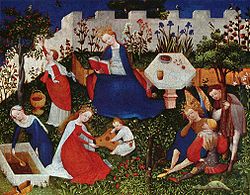
Upper Rhenish Master
Encyclopedia

Artist
An artist is a person engaged in one or more of any of a broad spectrum of activities related to creating art, practicing the arts and/or demonstrating an art. The common usage in both everyday speech and academic discourse is a practitioner in the visual arts only...
active ca. 1410-20 possibly in Strasbourg
Strasbourg
Strasbourg is the capital and principal city of the Alsace region in eastern France and is the official seat of the European Parliament. Located close to the border with Germany, it is the capital of the Bas-Rhin département. The city and the region of Alsace are historically German-speaking,...
. The most famous painting
Painting
Painting is the practice of applying paint, pigment, color or other medium to a surface . The application of the medium is commonly applied to the base with a brush but other objects can be used. In art, the term painting describes both the act and the result of the action. However, painting is...
of the artist is Paradiesgärtlein
Paradiesgärtlein
The Paradiesgärtlein is a panel painting created around 1410. The painter is unknown, referred to as the Meister des Frankfurter Paradiesgärtleins . The painting is executed in mixed techniques on wood; it measures about 26 by 33 centimetres...
(Little Garden of Paradise), a mixed technique on oakwood, 26.3 x 33.4 cm, now in the Städel Museum (on permanent loan from the Historical museum
Historical museum, Frankfurt
The Historical Museum in Frankfurt am Main was founded in 1878, and includes cultural and historical objects relating to the city's history...
in Frankfurt
Frankfurt
Frankfurt am Main , commonly known simply as Frankfurt, is the largest city in the German state of Hesse and the fifth-largest city in Germany, with a 2010 population of 688,249. The urban area had an estimated population of 2,300,000 in 2010...
since 1922). The painting is the Städel's most famous example of the old German school.
The unknown artist in this world famous painting depict a secluded scene, with Mary
Mary (mother of Jesus)
Mary , commonly referred to as "Saint Mary", "Mother Mary", the "Virgin Mary", the "Blessed Virgin Mary", or "Mary, Mother of God", was a Jewish woman of Nazareth in Galilee...
the Mother and Jesus
Jesus
Jesus of Nazareth , commonly referred to as Jesus Christ or simply as Jesus or Christ, is the central figure of Christianity...
the Child in it. A secluded corner of a castle garden. A peaceful place protected by a wall from the violent outer world. Then the painter applies what Albertus Magnus
Albertus Magnus
Albertus Magnus, O.P. , also known as Albert the Great and Albert of Cologne, is a Catholic saint. He was a German Dominican friar and a bishop, who achieved fame for his comprehensive knowledge of and advocacy for the peaceful coexistence of science and religion. Those such as James A. Weisheipl...
of Cologne, philosopher and father of the church, meant as "hortus conclusus
Hortus conclusus
Hortus conclusus is a Latin term, meaning literally "enclosed garden". "The word 'garden' is at root the same as the word 'yard'. It means an enclosure", observed Derek Clifford, at the outset of a series of essays on garden design, in which he skirted the conventions of the hortus conclusus...
".
"hortus conclusus" (Lat. 'enclosed garden')
a representation of the Virgin and Child in a fenced garden, sometimes accompanied by a group of female saints. The garden is a symbolic allusion to a phrase in the Song of Songs (4:12): 'A garden enclosed is my sister, my spouse'.
Some two hundred years later the Upper Rhenish Master realizes a painting that is designed for pleasure of spectators, but is also intended to be the vector of spiritual benefits. According to the 13th-century theologist, a pleasurable and sacred garden should contain "pleasant flowers .. trees .. animal .. a spring set in stone .. for its purity .. source of spiritual delectation" for a pious spectator.
Every detail of the Little Garden of Paradise stands for something more than itself. Many contemporary people were, probably, acquainted with symbols. If, in the Middle Ages few coul read, any visual form of communication was an effective instrument in order to spread the faith.
The Unknown artist dominates the use of symbols and orchestrates the stage as a playground not only appropriate for holy persons but for the new and upcoming vision of the nature, that will be a cornerstone in the 15th-century.

